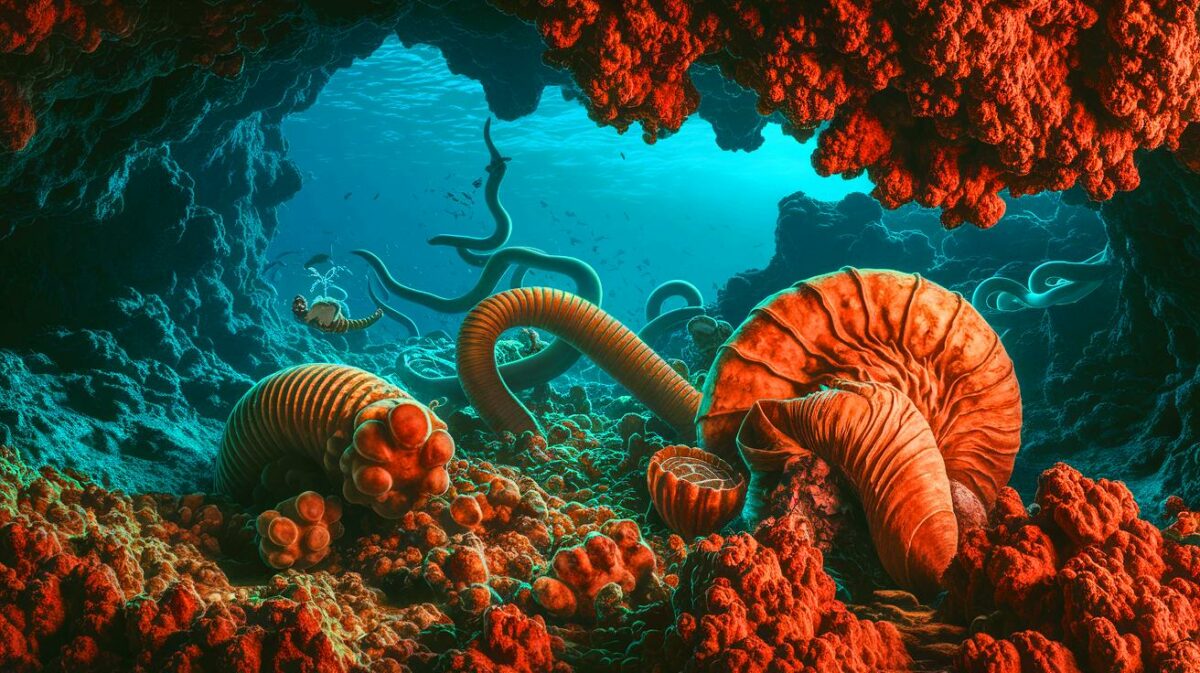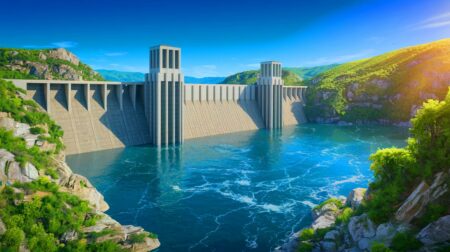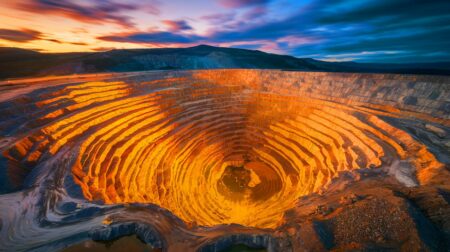| IN A NUTSHELL |
|
The depths of the ocean hold many secrets, but the recent discovery of giant creatures within the oceanic crust has shattered all expectations. At a depth of about 8,200 feet beneath the surface, an unexpected ecosystem thrives. This subterranean world, inhabited by giant worms and other forms of life, challenges our understanding of marine ecology and raises intriguing new questions about the evolution of life on Earth.
An Unexpected Ecosystem
Through the use of submersibles, researchers from the Schmidt Ocean Institute have uncovered a unique ecosystem in the depths of the Pacific. These modern explorers have revealed cavities filled with hydrothermal fluids, where giant creatures thrive. These geological structures, known as hydrothermal vents, have long been known to host microorganisms. However, for the first time, large animals, such as worms reaching up to 10 feet, have been observed there.
This discovery opens up new perspectives on the biodiversity of the oceanic crust. The presence of such large organisms in these extreme environments suggests a complex and previously unknown ecosystem that defies traditional biological paradigms. The implications for our understanding of life in extreme conditions are profound and far-reaching.
“Racing Past Rivals”: New US Hypersonic Testbed Contract Surges Ahead of Russia, China
A Diverse and Surprising Fauna
The diversity of life in these cavities is equally astounding. Among the species discovered, there are gastropods, cephalopods, and other mollusks previously unknown at these depths. Scientists have also observed larvae, suggesting that these young specimens might colonize the environment through the fluids of the hydrothermal vents, thereby establishing a connection between these subterranean ecosystems and those on the ocean floor.
Observations include Paralvinella spp clinging to the tubes of Riftia pachyptila, while Nereis sandersi delicately balances on the cavity’s roof. The elusive Branchinotogluma spp appears during exploration, and the semi-sessile Neomphalus fretterae rests in fascinating stillness, with Lepetodrilus spp hanging at the top as if suspended by an invisible thread. Such biodiversity highlights the potential for unknown life forms thriving in other unexplored parts of the ocean.
Implications for Scientific Knowledge
These discoveries upend our understanding of underwater dynamics. They suggest that vast portions of the oceanic crust could host complex life forms, challenging the limits of life in extreme environments. The protection of these unique ecosystems now becomes a pressing issue, especially in the face of mining threats that could disturb these singular habitats.
The scientific community is now faced with the task of understanding how these ecosystems function and what they can tell us about the resilience and adaptability of life. The potential for new biological and geological insights is tremendous, as these ecosystems may hold the key to understanding life’s development under extreme conditions.
| 🧩 Ecosystem | Discovery of a unique ecosystem in the oceanic depths |
| 🦠 Diversity | Presence of unknown gastropods and cephalopods |
| 🔬 Research | Use of submersibles to explore the depths |
| 🌍 Protection | Issue of protecting these unique ecosystems |
The Challenge of Exploration
The extent of this underground habitat remains to be defined. Some scientists suggest that life could extend much further, but conditions become increasingly extreme as one delves deeper into the crust. This uncertainty only amplifies the curiosity of researchers, who strive to unveil these hidden mysteries. Exploring these extreme environments is a technical challenge but also an opportunity to enrich our understanding of life on Earth.
As new discoveries continue to emerge, we are left with a critical question: How will we balance scientific exploration with the preservation of these fragile ecosystems? The pursuit of knowledge must align with our responsibility to protect the natural world.
Did you like it? 4.5/5 (23)









Wow, 10-foot worms? I hope they don’t start a wormhole trend! 🐍
Isn’t this how “The Meg” started?
Jason Statham should clear his schedule, we’re gonna need his diving and punching skills again.
Fascinating discovery! How do these creatures survive in such extreme conditions?
Does this mean there could be even larger creatures lurking deeper? 🤔
Great article! Thanks for sharing this groundbreaking research. 🌊
Could mining activities really destroy these ecosystems completely? 😟
How do scientists ensure that their exploration doesn’t harm these ecosystems?
I’m skeptical. How do we know these creatures aren’t just exaggerations?
What a discovery! It’s amazing to think about what else might be down there.
The ocean is full of surprises. Giant creatures sound like sci-fi! 🚀
Can these findings help us understand life on other planets?
How do they measure these giant worms without disturbing their habitat?
Thanks for the article, but what about the smaller creatures? 👀
Wait, did they mention a giant anaconda in the Amazon too? Is this related?
How long have these creatures been living in the oceanic crust?
I wonder if any of these animals could be domesticated. 🐠
Do you think these discoveries will change marine biology textbooks?
How do they keep the submersibles from getting lost in those depths?
Exciting news! Let’s hope mining companies listen to scientists this time.
I’m curious how these creatures affect the ocean’s ecosystem as a whole.
When will we see a documentary about these discoveries? I need visuals! 🎥
Are these animals dangerous to humans if encountered?
How did they even find these creatures in the first place?
This is incredible. Nature never ceases to amaze me. 🌍
Why is the protection of these ecosystems not a top priority already?
Did the article mention any potential for tourism in these areas?
So, are these creatures edible? Asking for a friend. 😜
What kind of technology is used to explore such deep ocean habitats?
Could these discoveries help us predict climate change impacts?
Do these worms have any predators, or are they the top of the food chain?
Is it possible that these ecosystems could have medicinal benefits?
Thats incredible! Could we eventually see these creatures in aquariums?
What are the next steps for scientists studying these ecosystems?
Are there any known threats to these creatures besides mining?
Thanks for the info! 🧠 It’s like Avatar, but underwater.
Why haven’t we found these creatures sooner? Are they really new?